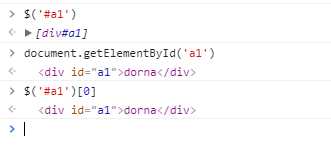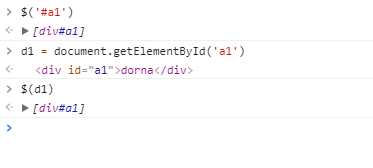标签:委派 on() 吸引 select png == use 结果 content
jQuery 对象就是通过jQuery包装DOM对象后产生的对象。jQuery 对象是 jQuery 独有的. 如果一个对象是 jQuery 对象, 那么它就可以使用 jQuery 里的方法: $(“#test”).html();
$("#test").html()
意思是指:获取ID为test的元素内的html代码。其中html()是jQuery里的方法
这段代码等同于用DOM实现代码: document.getElementById(" test ").innerHTML;
虽然jQuery对象是包装DOM对象后产生的,但是jQuery无法使用DOM对象的任何方法,同理DOM对象也不能使用jQuery里的方法.乱使用会报错
约定:如果获取的是 jQuery 对象, 那么要在变量前面加上$.
var $variable = jQuery 对象
var variable = DOM 对象
$variable[0]:jquery对象转为dom对象 $("#msg").html(); $("#msg")[0].innerHTML
jquery的基础语法:$(selector).action()
参考:http://jquery.cuishifeng.cn/
jQuery转换为Dom:

Dom转换为jQuery:

$("*") $("#id") $(".class") $("element") $(".class,p,div")
$(".outer div") $(".outer>div") $(".outer+div") $(".outer~div")
$("li:first") $("li:eq(2)") $("li:even") $("li:gt(1)")
$(‘[id="div1"]‘) $(‘["alex="sb"][id]‘)
$("[type=‘text‘]")----->$(":text") 注意只适用于input标签 : $("input:checked")
:enabled
:disabled
:checked
:selected

<body>
<form>
<input type="checkbox" value="123" checked>
<input type="checkbox" value="456" checked>
<select>
<option value="1">Flowers</option>
<option value="2" selected="selected">Gardens</option>
<option value="3" selected="selected">Trees</option>
<option value="3" selected="selected">Trees</option>
</select>
</form>
<script src="jquery.min.js"></script>
<script>
// console.log($("input:checked").length); // 2
// console.log($("option:selected").length); // 只能默认选中一个,所以只能lenth:1
$("input:checked").each(function(){
console.log($(this).val())
})
</script>
</body>
$("li").eq(2) $("li").first() $("ul li").hasclass("test")
查找子标签: $("div").children(".test") $("div").find(".test")
向下查找兄弟标签: $(".test").next() $(".test").nextAll()
$(".test").nextUntil()
向上查找兄弟标签: $("div").prev() $("div").prevAll()
$("div").prevUntil()
查找所有兄弟标签: $("div").siblings()
查找父标签: $(".test").parent() $(".test").parents()
$(".test").parentUntil()
页面载入
ready(fn) // 当DOM载入就绪可以查询及操纵时绑定一个要执行的函数。 $(document).ready(function(){}) -----------> $(function(){})
事件绑定
//语法: 标签对象.事件(函数) eg: $("p").click(function(){})
事件委派:
$("").on(eve,[selector],[data],fn) // 在选择元素上绑定一个或多个事件的事件处理函数。

<ul>
<li>1</li>
<li>2</li>
<li>3</li>
</ul>
<hr>
<button id="add_li">Add_li</button>
<button id="off">off</button>
<script src="jquery.min.js"></script>
<script>
$("ul li").click(function(){
alert(123)
});
$("#add_li").click(function(){
var $ele=$("<li>");
$ele.text(Math.round(Math.random()*10));
$("ul").append($ele)
});
// $("ul").on("click","li",function(){
// alert(456)
// })
$("#off").click(function(){
$("ul li").off()
})
</script>
事件切换
hover事件:
一个模仿悬停事件(鼠标移动到一个对象上面及移出这个对象)的方法。这是一个自定义的方法,它为频繁使用的任务提供了一种“保持在其中”的状态。
over:鼠标移到元素上要触发的函数
out:鼠标移出元素要触发的函数

<!DOCTYPE html>
<html lang="en">
<head>
<meta charset="UTF-8">
<title>Title</title>
<style>
*{
margin: 0;
padding: 0;
}
.test{
width: 200px;
height: 200px;
background-color: wheat;
}
</style>
</head>
<body>
<div class="test"></div>
</body>
<script src="jquery.min.js"></script>
<script>
// function enter(){
// console.log("enter")
// }
// function out(){
// console.log("out")
// }
// $(".test").hover(enter,out)
$(".test").mouseenter(function(){
console.log("enter")
});
$(".test").mouseleave(function(){
console.log("leave")
});
</script>
</html>
--------------------------CSS类 $("").addClass(class|fn) $("").removeClass([class|fn]) --------------------------属性 $("").attr(); $("").removeAttr(); $("").prop(); $("").removeProp(); --------------------------HTML代码/文本/值 $("").html([val|fn]) $("").text([val|fn]) $("").val([val|fn|arr]) --------------------------- $("#c1").css({"color":"red","fontSize":"35px"})

<input id="chk1" type="checkbox" />是否可见 <input id="chk2" type="checkbox" checked="checked" />是否可见 <script> //对于HTML元素本身就带有的固有属性,在处理时,使用prop方法。 //对于HTML元素我们自己自定义的DOM属性,在处理时,使用attr方法。 //像checkbox,radio和select这样的元素,选中属性对应“checked”和“selected”,这些也属于固有属性,因此 //需要使用prop方法去操作才能获得正确的结果。 // $("#chk1").attr("checked") // undefined // $("#chk1").prop("checked") // false // ---------手动选中的时候attr()获得到没有意义的undefined----------- // $("#chk1").attr("checked") // undefined // $("#chk1").prop("checked") // true console.log($("#chk1").prop("checked"));//false console.log($("#chk2").prop("checked"));//true console.log($("#chk1").attr("checked"));//undefined console.log($("#chk2").attr("checked"));//checked </script>
我们知道,
$("p").css("color","red")
是将css操作加到所有的标签上,内部维持一个循环;但如果对于选中标签进行不同处理,这时就需要对所有标签数组进行循环遍历啦
jquery支持两种循环方式:
方式一:
格式:$.each(obj,fn)
li=[10,20,30,40]; dic={name:"yuan",sex:"male"}; $.each(li,function(i,x){ console.log(i,x) });
方式二
格式:$("").each(fn)
$("tr").each(function(){
console.log($(this).html())
})
其中,$(this)代指当前循环标签。
each扩展

/* function f(){ for(var i=0;i<4;i++){ if (i==2){ return } console.log(i) } } f(); // 这个例子大家应该不会有问题吧!!! //----------------------------------------------------------------------- li=[11,22,33,44]; $.each(li,function(i,v){ if (v==33){ return ; // ===试一试 return false会怎样? } console.log(v) }); //------------------------------------------ // 大家再考虑: function里的return只是结束了当前的函数,并不会影响后面函数的执行 //本来这样没问题,但因为我们的需求里有很多这样的情况:我们不管循环到第几个函数时,一旦return了, //希望后面的函数也不再执行了!基于此,jquery在$.each里又加了一步: for(var i in obj){ ret=func(i,obj[i]) ; if(ret==false){ return ; } } // 这样就很灵活了: // <1>如果你想return后下面循环函数继续执行,那么就直接写return或return true // <2>如果你不想return后下面循环函数继续执行,那么就直接写return false // ---------------------------------------------------------------------
//创建一个标签对象 $("<p>") //内部插入 $("").append(content|fn) ----->$("p").append("<b>Hello</b>"); $("").appendTo(content) ----->$("p").appendTo("div"); $("").prepend(content|fn) ----->$("p").prepend("<b>Hello</b>"); $("").prependTo(content) ----->$("p").prependTo("#foo"); //外部插入 $("").after(content|fn) ----->$("p").after("<b>Hello</b>"); $("").before(content|fn) ----->$("p").before("<b>Hello</b>"); $("").insertAfter(content) ----->$("p").insertAfter("#foo"); $("").insertBefore(content) ----->$("p").insertBefore("#foo"); //替换 $("").replaceWith(content|fn) ----->$("p").replaceWith("<b>Paragraph. </b>"); //删除 $("").empty() $("").remove([expr]) //复制 $("").clone([Even[,deepEven]])

<!DOCTYPE html>
<html lang="en">
<head>
<meta charset="UTF-8">
<title>Title</title>
<script src="jquery-2.1.4.min.js"></script>
<script>
$(document).ready(function() {
$("#hide").click(function () {
$("p").hide(1000);
});
$("#show").click(function () {
$("p").show(1000);
});
//用于切换被选元素的 hide() 与 show() 方法。
$("#toggle").click(function () {
$("p").toggle();
});
})
</script>
<link type="text/css" rel="stylesheet" href="style.css">
</head>
<body>
<p>hello</p>
<button id="hide">隐藏</button>
<button id="show">显示</button>
<button id="toggle">切换</button>
</body>
</html>

<!DOCTYPE html>
<html lang="en">
<head>
<meta charset="UTF-8">
<title>Title</title>
<script src="jquery-2.1.4.min.js"></script>
<script>
$(document).ready(function(){
$("#slideDown").click(function(){
$("#content").slideDown(1000);
});
$("#slideUp").click(function(){
$("#content").slideUp(1000);
});
$("#slideToggle").click(function(){
$("#content").slideToggle(1000);
})
});
</script>
<style>
#content{
text-align: center;
background-color: lightblue;
border:solid 1px red;
display: none;
padding: 50px;
}
</style>
</head>
<body>
<div id="slideDown">出现</div>
<div id="slideUp">隐藏</div>
<div id="slideToggle">toggle</div>
<div id="content">helloworld</div>
</body>
</html>

<!DOCTYPE html>
<html lang="en">
<head>
<meta charset="UTF-8">
<title>Title</title>
<script src="jquery-2.1.4.min.js"></script>
<script>
$(document).ready(function(){
$("#in").click(function(){
$("#id1").fadeIn(1000);
});
$("#out").click(function(){
$("#id1").fadeOut(1000);
});
$("#toggle").click(function(){
$("#id1").fadeToggle(1000);
});
$("#fadeto").click(function(){
$("#id1").fadeTo(1000,0.4);
});
});
</script>
</head>
<body>
<button id="in">fadein</button>
<button id="out">fadeout</button>
<button id="toggle">fadetoggle</button>
<button id="fadeto">fadeto</button>
<div id="id1" style="display:none; width: 80px;height: 80px;background-color: blueviolet"></div>
</body>
</html>

<!DOCTYPE html>
<html lang="en">
<head>
<meta charset="UTF-8">
<title>Title</title>
<script src="jquery-2.1.4.min.js"></script>
</head>
<body>
<button>hide</button>
<p>helloworld helloworld helloworld</p>
<script>
$("button").click(function(){
$("p").hide(1000,function(){
alert($(this).html())
})
})
</script>
</body>
</html>
css位置操作
$("").offset([coordinates])
$("").position()
$("").scrollTop([val])
$("").scrollLeft([val])

<!DOCTYPE html>
<html lang="en">
<head>
<meta charset="UTF-8">
<title>Title</title>
<style>
.test1{
width: 200px;
height: 200px;
background-color: wheat;
}
</style>
</head>
<body>
<h1>this is offset</h1>
<div class="test1"></div>
<p></p>
<button>change</button>
</body>
<script src="jquery-3.1.1.js"></script>
<script>
var $offset=$(".test1").offset();
var lefts=$offset.left;
var tops=$offset.top;
$("p").text("Top:"+tops+" Left:"+lefts);
$("button").click(function(){
$(".test1").offset({left:200,top:400})
})
</script>
</html>

<!DOCTYPE html>
<html lang="en">
<head>
<meta charset="UTF-8">
<title>Title</title>
<style>
*{
margin: 0;
}
.box1{
width: 200px;
height: 200px;
background-color: rebeccapurple;
}
.box2{
width: 200px;
height: 200px;
background-color: darkcyan;
}
.parent_box{
position: relative;
}
</style>
</head>
<body>
<div class="box1"></div>
<div class="parent_box">
<div class="box2"></div>
</div>
<p></p>
<script src="jquery-3.1.1.js"></script>
<script>
var $position=$(".box2").position();
var $left=$position.left;
var $top=$position.top;
$("p").text("TOP:"+$top+"LEFT"+$left)
</script>
</body>
</html>

<!DOCTYPE html>
<html lang="en">
<head>
<meta charset="UTF-8">
<title>Title</title>
<style>
body{
margin: 0;
}
.returnTop{
height: 60px;
width: 100px;
background-color: peru;
position: fixed;
right: 0;
bottom: 0;
color: white;
line-height: 60px;
text-align: center;
}
.div1{
background-color: wheat;
font-size: 5px;
overflow: auto;
width: 500px;
height: 200px;
}
.div2{
background-color: darkgrey;
height: 2400px;
}
.hide{
display: none;
}
</style>
</head>
<body>
<div class="div1 div">
<h1>hello</h1>
<h1>hello</h1>
<h1>hello</h1>
<h1>hello</h1>
<h1>hello</h1>
<h1>hello</h1>
<h1>hello</h1>
<h1>hello</h1>
<h1>hello</h1>
<h1>hello</h1>
<h1>hello</h1>
<h1>hello</h1>
<h1>hello</h1>
<h1>hello</h1>
<h1>hello</h1>
<h1>hello</h1>
</div>
<div class="div2 div"></div>
<div class="returnTop hide">返回顶部</div>
<script src="jquery-3.1.1.js"></script>
<script>
$(window).scroll(function(){
var current=$(window).scrollTop();
console.log(current);
if (current>100){
$(".returnTop").removeClass("hide")
}
else {
$(".returnTop").addClass("hide")
}
});
$(".returnTop").click(function(){
$(window).scrollTop(0)
});
</script>
</body>
</html>
尺寸操作
$("").height([val|fn])
$("").width([val|fn])
$("").innerHeight()
$("").innerWidth()
$("").outerHeight([soptions])
$("").outerWidth([options])

<!DOCTYPE html>
<html lang="en">
<head>
<meta charset="UTF-8">
<title>Title</title>
<style>
*{
margin: 0;
}
.box1{
width: 200px;
height: 200px;
background-color: wheat;
padding: 50px;
border: 50px solid rebeccapurple;
margin: 50px;
}
</style>
</head>
<body>
<div class="box1">
DIVDIDVIDIV
</div>
<p></p>
<script src="jquery-3.1.1.js"></script>
<script>
var $height=$(".box1").height();
var $innerHeight=$(".box1").innerHeight();
var $outerHeight=$(".box1").outerHeight();
var $margin=$(".box1").outerHeight(true);
$("p").text($height+"---"+$innerHeight+"-----"+$outerHeight+"-------"+$margin)
</script>
</body>
</html>
扩展jQuery对象本身。
用来在jQuery命名空间上增加新函数。
在jQuery命名空间上增加两个函数:
<script> jQuery.extend({ min: function(a, b) { return a < b ? a : b; }, max: function(a, b) { return a > b ? a : b; } }); jQuery.min(2,3); // => 2 jQuery.max(4,5); // => 5 </script>
扩展 jQuery 元素集来提供新的方法(通常用来制作插件)
增加两个插件方法:
<body> <input type="checkbox"> <input type="checkbox"> <input type="checkbox"> <script src="jquery.min.js"></script> <script> jQuery.fn.extend({ check: function() { $(this).attr("checked",true); }, uncheck: function() { $(this).attr("checked",false); } }); $(":checkbox:gt(0)").check() </script> </body>
标签:委派 on() 吸引 select png == use 结果 content
原文地址:http://www.cnblogs.com/qiangyuge/p/7726068.html